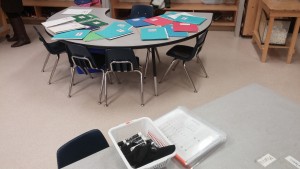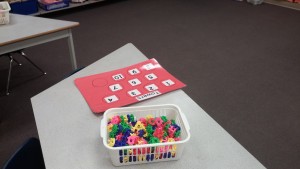March 10th, 2016
I am super tired and exhausted today but at the same it was definitely filled with lots of rewarding moments!
Here is my post, I wanted to jot it down before I forget.
Hectic Morning
I got up at 5:00 am to do a last triple check on my leprechaun scavenger hunt material, and it was within half an hour that the power went out in my area! Stunned but had to think fast on what to do! I used my laptop screen light to tidy up everything and tried to get dressed for the day.
I started texting Harmeen and Sabrina at around 6:00am to ask them if they were experiencing power outages because I know they live quite close to Creekside. I thought about Harmeen first because I wanted to give her an update on Bothwell as I live just across from the street so she is aware. I used my data to check for outage info and school closure, but nothing was updated yet at that time. I notified Kal too, telling her that I don’t have power in my area. Harmeen, Sabrina and Kal all responded saying they have power in their area. So, I made a decision that I need to tell my dad to manually pull up the garage door, and we need to head out much earlier than we usually do as I was worried about possible traffic light/ road problems!
I arrived at school much earlier than usual at around 7:35am. Whew! What a morning!
I settled down and got my morning St. Patrick’s art lesson ready, got the youtube music clip ready, went to the paper room to get additional pastel supplies.
Questions: What do I do if a child was injured? (thinking ahead into practicum if something does happen during class)
I did ask Kal and other staff the protocols for power outage and school closures! I also asked her in case if any students were injured in a group setting (gym or in class), what steps and priority decision making she would take. (E.g. bolting away, bleeding, head injury, …etc) She said always the group should be kept as a priority. We can phone the office for additional support about the concerned individual, or ask another staff in the hallway for aid, and of course there could always be extenuating circumstance and exceptions.)
St. Patricks’ Art (morning activity with scavenger extension in the afternoon)
I am starting to feel a bit more comfortable but definitely still work in progress with the pacing of my instruction. There were definitely times I need to exaggerate and use really hyped up enthusiasm with the kids by introducing their work as not just “work” rather “A REALLY FUN activity!” I definitely feel the students were working quite smoothly through my many progressions with the 2-piece art (pot & leprechaun) Of course, there were once or twice I had to bring the kids altogether to clarify a few minor steps. In general, I can see and feel they are fully engaged and willing to take the time to work on their details. My prep into creating the templates was worth it as I heard their extended excitement and conversation post-activity, during recess, and lunch time. I wanted to make my activity today not only encompassing art but also providing an experiential learning, thus I created the scavenger hunt.
I knew it was the first time for most of my kids to learn about leprechaun, so I did a short intro with a music video and a picture book, followed by art. But, I didn’t want to end just there! I wanted if I can to give my student an opportunity to experience the taste of the magical world
Kal went to the gym as I stayed behind for about 8 minutes to ensure all details were taken care of. I then quickly joined them in the gym for dodgeball as I didn’t want the kids to have too much suspicion. As we came back from the gym, usually they go right into centre time, but we told them to get a drink of water and come sit at the carpet. The kids were amazingly observant! One saw a clue on the door and then it snowballed into roof-raising excitement with the whole class. They were making connections to our gingerbread man hunt back in December as they had to be detectives for a school-wide search! I downgraded to a class search because I knew everyone (office secretaries/ librarian…etc..) was busy with the open house today and I didn’t want to add onto their stress level. Most of the kids bought into the magical idea, but still thought it was unbelievable that their leprechauns sneakily escaped! It was hard not to smile with joy hearing some of their predictions and assumptions of why their leprechauns ran away. They definitely couldn’t hide their anticipation! Originally, we were going to walk around to find the clues with the whole class. But, both my SA and I felt the kids were TOO excited to the point that they might start to run around to get to the next clue. So, we decided to sit down at the carpet where we all can see most of the clue except for the last one. We asked a few kids including the special helper to bring a clue up to us at the carpet instead of all 20 kids swarming at every clue location. Even with them sitting at the carpet, there were definitely times I felt I had a crowd of leopard ready to launch for its prey every time a kids brings up a clue for me to read aloud together with the class! I did not picture how thrilled they were with this activity, because I was worried what if they were literally expecting “a pot of gold.” I filled my goodie bag with one golden chocolate loonie and the rest with luck charm cereal. I thought I could find the chocolate coins at the dollar store, but I couldn’t, so I had to buy it in bulk, and they were relatively costly. If they were cheap, I would have filled their bags all with coins, but economically-friendly, I couldn’t. Surprisingly, the kids didn’t really pay attention but was still hung on the whole scavenger process and was glad even to dig into the lucky charm cereal bag to discover that single chocolate coin!
I have to admit it was a ton of work into the prepping, hiding their work, leaving traces, clues, and placing the reward in their pots! However, with the joy on their face, they sound of excitement, the awe at the magical disappearance, and seeing them extending their experience into creating self-directed “scavenger clues” during centre time was much more than I can ask for! The whole experience was priceless. I want my kids to feel my strong presence before going off to spring break and hopefully hold its reminiscence till I start on March 29. I want this pre-St. Patrick celebration to be a memorable one for them and hopefully they will be ready to have more fun ways of learning and exploring with me!
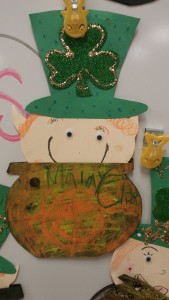
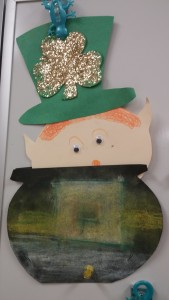
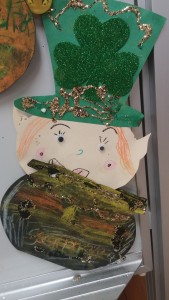
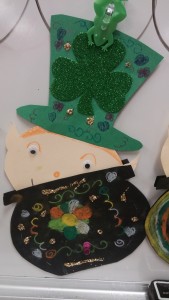
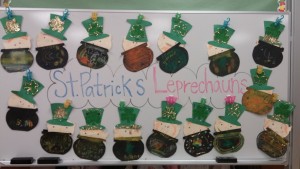
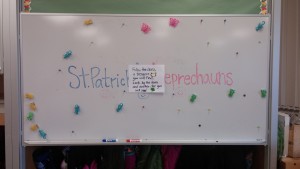
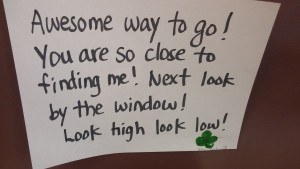
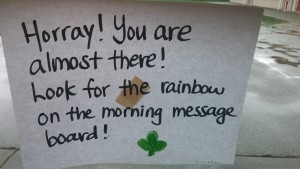
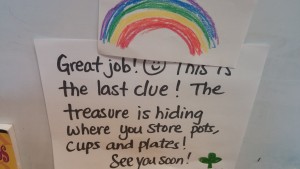

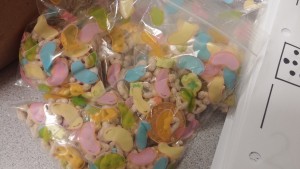
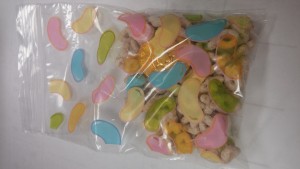
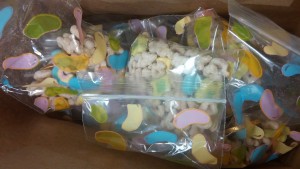
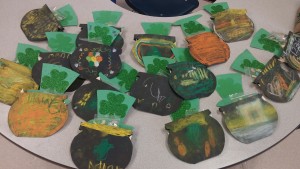
Staff Dinner (5PM-6PM)
Great bonding time with our fellow staff at Creekside! Sadly, it’s Manjit ‘s last day tomorrow! Most of the staff only found out yesterday! The newsletter went home today! We will meet our new VP when we start after spring break.
Open House (6PM-7PM)
It was a great turn out! At the start we only had a few families but as the night progressed we were full housed! Only 4 families out of my 21 students didn’t make it to the open night either due to away on vacation or sick. We had our math centres set up, allowing students to show and play familiar class activities with their siblings, parents, and grandparents. They could also show their family their work around the room. Our literacy teacher, Paige (Ms. W) and I were also helping facilitate and explaining “the writing sample folder” which documents student progress from September till now with student work and tracking rubric. I really valued the opportunity to casually chat with my students’ families especially for those family members I haven’t met. I definitely feel my continuous greetings and brief chatting at the door on Thursday mornings have come together quite nicely in helping me establishing a foundation to building good rapport. As I was chatting with my students’ families today and the past few weeks, I did let them know that after spring break, they will start to see more and “lots” of me!
